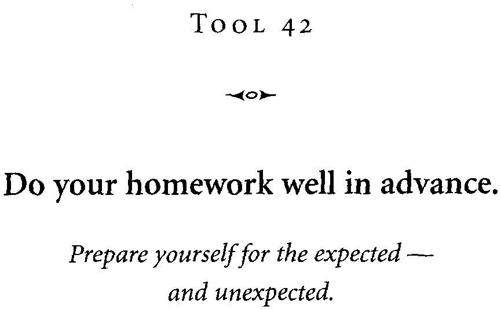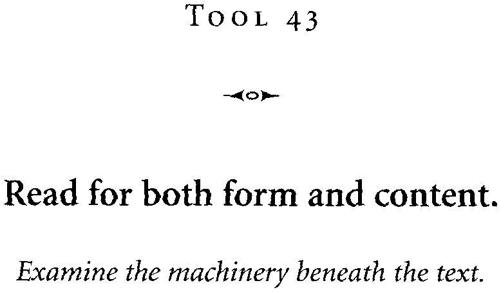Writing Tools (27 page)
Authors: Roy Peter Clark

• Keep a daybook.
Story ideas, key phrases, a startling insight, these can be fleeting. A handy companion, like a notebook, laptop, or daybook, helps you preserve the stimuli and ingredients for new writing.
WORKSHOP
1. For your next project, begin writing much earlier than you think you can. Write a summary of the day's research. Write a memo to yourself on what you've learned. Write a conditional first paragraph. Let all of this writing teach you what else you need to learn.
2. Have a conversation with a writer who seems to be procrastinating. In a diplomatic and supportive way, ask open-ended questions about the writing: What are you working on? How's it going? It turns out that talking about writing can transform procrastination into rehearsal, maybe even into action.
3. If you are a plodder, it may be worth your time to experiment with some forms of freewriting. If you are stuck, try writing on your current topic, for three minutes, as fast as you can. The purpose is not to create a draft, but to build momentum.
4. For one month, keep a daybook. Use it to jot down ideas and capture some phrases. Tell yourself that no sentence in your daybook will appear in your finished work. This will help lower your standards. Now write some memos to yourself. This early writing may help speed up your process.

That great writing coach Prince Hamlet said it best: "the readiness is all." Good writers prepare for the next big writing project, even if it is not yet on the radar screen. They expect the unexpected. Like Batman, they cinch up a utility belt loaded with handy tools. They fill a reservoir of knowledge they can drain at a moment's notice.
Virginia Woolf argued famously that to prepare to write fiction, women would need some money and "a room of one's own." Her contemporary, Dorothea Brande, described a more disciplined form of writing preparation:
Mind you, you are not yet to write it. The work you are doing on it is preliminary. For a day or two you are going to immerse yourself in these details; you are going to think about them consciously, turning if necessary to books of reference to fill in
your facts. Then you are going to dream about it----There will
seem no end to the stuff that you can find to work over. What does the heroine look like? Was she an only child, or the eldest of several? How was she educated? Does she work? (from
Becoming a Writer)
She then cites novelist Ford Madox Ford, who adhered to an even more exacting regimen:
I may. .. plan out every scene ... in a novel before I sit down to write it.... I must know — from personal observation, not reading — the shapes of windows, the nature of doorknobs, the aspect of kitchens, the material of which dresses are made, the leather used in shoes, the method used in manuring fields, the nature of bus tickets. I shall never use any of these things in the book. But unless I know what sort of doorknob his fingers close on how shall I... get my character out of doors?
All writers can learn from sports journalists, the world champions of readiness. They write stories of national and international interest, under excruciating deadline pressure, against formidable competition and with the outcome of the event in doubt. A Herculean task. Bill Plaschke of the
Los Angeles Times
was prepared when Justin Gatlin won the 2004 Olympic gold in the 100-meter dash:
His first track event was the 100-meter hydrants, a Brooklyn kid running down Quentin Street leaping over every fire plug in his path.
His second track event was the 100-meter spokes, the kid racing in tennis shoes against his friends riding bicycles.
A dozen years later, on a still Mediterranean night far from home, the restless boy on the block became the fastest man in the world.
Plaschke could not have written this great deadline lead without doing his homework — hours of research in anticipation of who might win the race.
Writing the big game story requires readiness enough. Now try to imagine what it took for Associated Press correspondent
Mark Fritz to write this 1994 account of the genocidal massacre in Rwanda:
Nobody lives here anymore.
Not the expectant mothers huddled outside the maternity clinic, not the families squeezed into the church, not the man who lies rotting in a schoolroom beneath a chalkboard map of Africa.
Everybody here is dead. Karubamba is a vision from hell, a flesh-and-bone junkyard of human wreckage, an obscene slaughterhouse that has fallen silent save for the roaring buzz of flies the size of honeybees.
For such principled work, Fritz won a Pulitzer Prize. One admirer remarked: "What makes his stories exceptional, beyond the enterprise and raw courage they demanded, was the homework — reading, research, scouring databases, interviewing experts — that preceded his field reporting."
Few writers in America are as versatile as David Von Drehle, book author and reporter for the
Washington Post.
When in 1994 he was assigned to cover the funeral of former president Richard Nixon, Von Drehle knew he'd be writing on deadline against a small army of competitors. "Deadlines always make me shiver," he admits, but the shivers are a physical manifestation of his readiness to produce prose like this:
YORBA LINDA, Calif. — When last the nation saw them all together, they were men of steel and bristling crew cuts, titans of their time — which was a time of pragmatism and ice water in the veins.
How boldly they talked. How fearless they seemed. They spoke of fixing their enemies, of running over their own grandmothers if it would give them an edge. Their goals were the goals of giants:
Control of a nation, victory in the nuclear age, strategic domination of the globe.
The titans of Nixon's age gathered again today, on an unseasonably cold and gray afternoon, and now they were white-haired or balding, their steel was rusting, their skin had begun to sag, their eyesight was failing. They were invited to contemplate where power leads.
Such work is no accident, and Von Drehle shares the secrets of readiness. Under pressure, he falls back on the basics, thinks about what happened, why it matters, and how he can turn it into a story. He must do enough homework to answer these three questions:
1. What's the point?
2. Why is this story being told?
3. What does it say about life, about the world, about the times we live in?
I end with the story of a famous foreign correspondent and novelist, Laurence Stallings, who was assigned in 1925 to cover a big college football game between Pennsylvania and Illinois. The star of the day was Red Grange. Known as the Galloping Ghost, Grange dazzled the crowd with 363 yards of total offense, leading the Illini to a 24-2 upset victory over Penn.
The famous journalist and author was awestruck. Red Smith wrote that Stallings "clutched at his haircut" as he paced up and down the pressbox. How could anyone cover this event? "It's too big," he said, "I can't write it," this coming from a man who had once covered World War I.
Someone should have quoted Shakespeare to him: "the readiness is all."
WORKSHOP
1. With the help of a friend, list possible big writing projects that could emerge from your specialty or area of interest. Begin homework on these topics, preparation that will help you down the road.
2. As you watch big sporting events, such as the World Series or the Super Bowl or the Olympics, rehearse in your head possible scenes you would write for the most dramatic stories. Compare and contrast your approaches with those that appear in print and on air.
3. Big stories need good titles. Review your recent work to see if your titles match the intensity and quality of the text. For your next project, brainstorm titles early in the process to focus your research and writing.
4. If you write fiction, review the process of research and preparation for novelists described by Brande and Ford. Try using those strategies as homework for a short story. If they work for you, apply them to more ambitious projects.

By the third grade, I knew I was a good reader. My teacher, Miss Kelly, told me so. She was impressed, she said, that I could recognize the word
gigantic
in a story about Davy Crockett, who killed "a gigantic bear." Why, then, did it take me twenty more years to imagine that I was a writer? Perhaps it's because we teach and learn reading as a democratic craft — necessary for education, vocation, and citizenship — but writing as a fine art. Everyone should read, we say, but we act as if only those with special talent should write.
One thing we know for sure: writers read for both form and content.
If you piece together a puzzle, you benefit from the image on the box. If you try a new recipe, it helps to see a photo of the finished dish. If you work with wood, you need to know the difference between a bookcase and a credenza. The writer must answer this question: what am I trying to build? And then this one: what tools do I need to build it?
Whenever I take a big step in my writing, I begin by reading. Of course, I read for content. If I'm writing about anti-Semitism, I read Holocaust memoirs. If I'm writing about AIDS, I read biomedical texts and social histories of the disease. If I'm writing about World War II, I read magazines from the 1940s. So, by all means, read for content.
But also read for form, for genre. If you want to write better photo captions, read old issues of
LIFE
magazine. If you want to become a better explainer, read a great cookbook. If you want to write clever headlines, read the big city tabloids. If you want to write a screenplay about a superhero, read stacks of comic books. If you want to write witty short features, read The Talk of the Town in
New Yorker
magazine.
In her memoir
The Year of Magical Thinking,
Joan Didion describes a moment in the life of her late husband, author John Gregory Dunne:
[ W]hen we were living in Brentwood Park we fell into a pattern of stopping work at four in the afternoon and going out to the pool. He would stand in the water reading (he reread
Sophie's Choice
several times that summer trying to see how it worked) while I worked in the garden.
That's how smart writers continue to learn, by reading work they admire again and again "to see how it works."
I started work on "Three Little Words," the long newspaper serial in short chapters, by searching for models. I read Dickens, whose novels were serialized. I read
Winesburg, Ohio,
a series of connected short stories by Sherwood Anderson. I read
The Story of a Shipwrecked Sailor,
a serialized newspaper story by Gabriel Garcia Marquez. In all these cases, the chapters were too long. Surprisingly, I found my pattern in the adventure stories of my youth. The Hardy Boys and Nancy Drew mysteries had chapters I could read in about five minutes or less, with a mini-cliffhanger at the end.
When you find you
can't
put a story down,
you should
put the story down. Put it down and think about how it works. What magic did the writer conjure to propel you from paragraph to paragraph, page to page, chapter to chapter?
